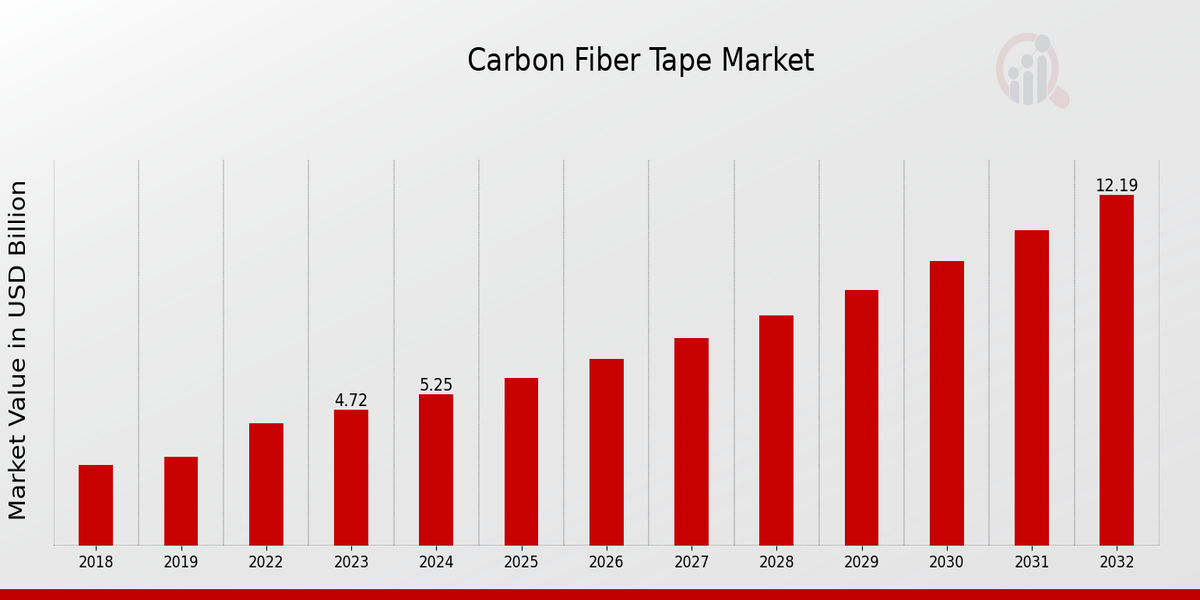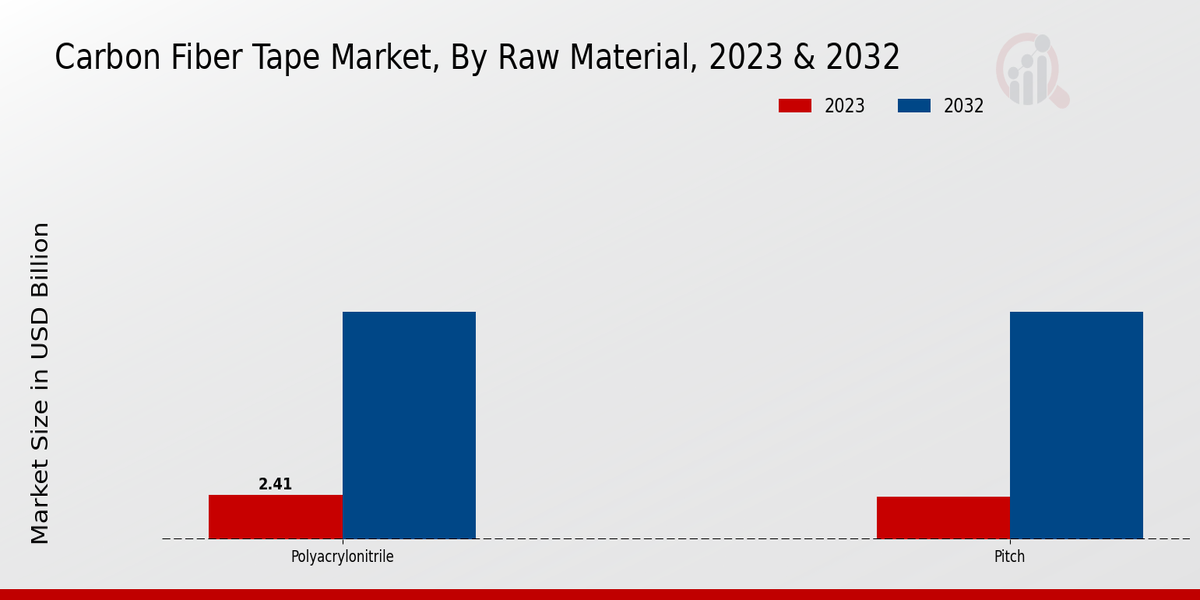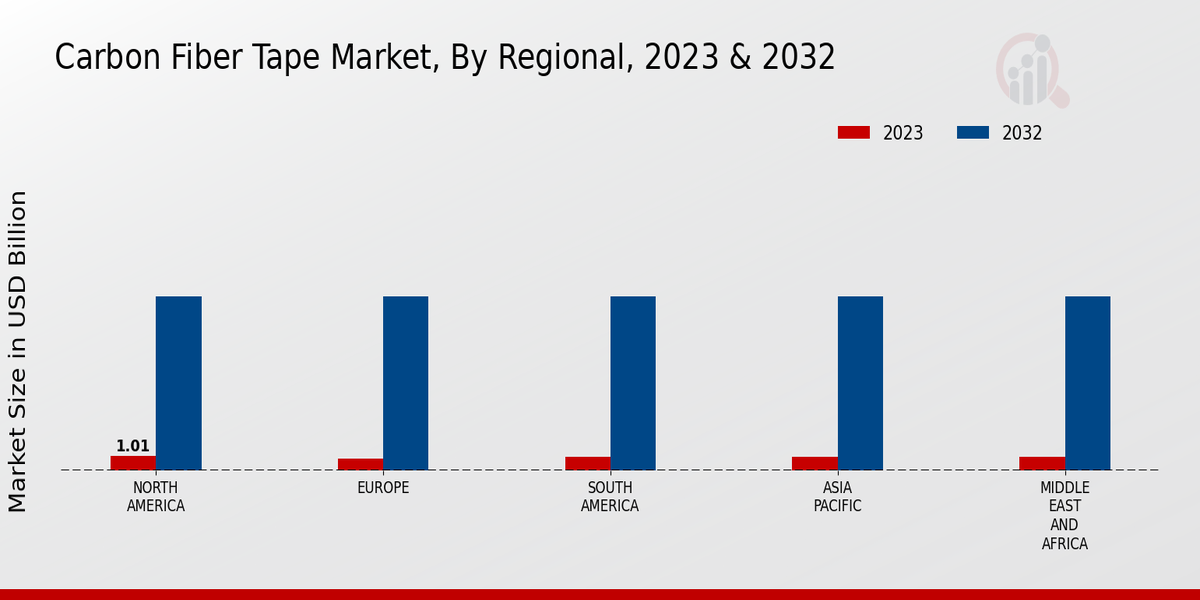Global Carbon Fiber Tape Market Overview
The Carbon Fiber Tape Market Size was estimated at 4.25 (USD Billion) in 2022.The Carbon Fiber Tape Industry is expected to grow from 4.72(USD Billion) in 2023 to 12.2 (USD Billion) by 2032. The Carbon Fiber Tape Market CAGR (growth rate) is expected to be around 11.11% during the forecast period (2024 - 2032).
Key Carbon Fiber Tape Market Trends Highlighted
The global market for carbon fiber tape is driven by increasing demand from various industries such as aerospace, automotive, and construction. The aerospace industry is a major consumer, using carbon fiber tape for lightweight and durable aircraft components. In the automotive sector, carbon fiber tape is used to reduce the weight of vehicles, improving fuel efficiency and performance. The construction industry utilizes carbon fiber tape for reinforcing concrete structures, bridges, and buildings, enhancing their strength and durability. Other key drivers include the growing adoption of wind energy applications, rising demand for lightweight and high-performance materials, and increasing awareness of carbon fiber's environmental benefits.Opportunities for growth in the carbon fiber tape market lie in the exploration of advanced manufacturing technologies, such as automated tape placement (ATP), which enhances efficiency and reduces production costs. Additionally, expanding applications in emerging industries like medical devices and electronics present untapped potential. Trends in recent times include the emergence of hybrid materials combining carbon fiber with other materials like glass or ceramic fibers to create tailored properties. Sustainable and eco-friendly carbon fiber production methods are also gaining traction, addressing environmental concerns and attracting environmentally conscious consumers.
Source: Primary Research, Secondary Research, MRFR Database and Analyst Review
Carbon Fiber Tape Market Drivers
Rising Demand for Lightweight and High-Strength Materials in Automotive and Aerospace Industries
Automotive and aerospace businesses are the principal players in the global carbon fiber tape market. The implementation of carbon fiber tapes has been growing in these markets since these tapes are lightweight and oxidation-proof. For instance, the use of carbon fiber tape in cars results in a reduction in the overall vehicle weight, making it more fuel-efficient. Carbon fiber tapes also provide an effective resistance between different materials and demonstrate a high fatigue strength.The accelerated demand for lighter and stiffer materials continues the expansion of carbon fiber tape.
Increasing Adoption of Carbon Fiber Tapes in Sporting Goods and Consumer Electronics
There is a growing demand for carbon fiber tapes in the sporting goods industry. These tapes are used to make high-performance sports equipment, such as tennis rackets, golf clubs, and bicycle frames. The increased stiffness and strength of the tapes make the equipment more durable and efficient. In addition, carbon fiber tapes are used in the consumer electronics industry to produce lightweight and sturdy electronic devices, such as laptops, smartphones, and tablets.Such products are becoming more popular due to the demand for lightweight and high-performance products in modern industries.
Government Initiatives and Regulations Promoting the Use of Carbon Fiber Tapes
Initiatives and regulations are being implemented by the government worldwide to promote the use of carbon fiber tapes in the industry. For example, the government provides tax incentives, subsidies, and research grants to the industry to use carbon fiber tapes. In addition to this, the government also implements regulations that require the use of lightweight and high-strength materials for certain applications, such as the automotive and aerospace industries.All these initiatives are expected to promote the growth of the carbon fiber tape market in order to increase the demand for carbon fiber tapes in the industry
Carbon Fiber Tape Market Segment Insights:
Carbon Fiber Tape Market Raw Material Insights
The global carbon fiber tape market is segmented by raw material into polyacrylonitrile and pitch. PAN is the most common raw material used to manufacture carbon fibers, accounting for over 90% of global production. The PAN-based carbon fibers are highly strong, stiff, and possess high modulus, which makes them ideal for high-performance applications in industries such as aerospace, automotive, and sports equipment. The global PAN-based carbon fiber tape market is expected to witness a CAGR of over 10% during the forecast period of 2021 and 2032, which can be attributed to the increasing demand for lightweight and durable materials in these industries.The pitch-based carbon fibers are manufactured from petroleum or coal tar pitch and are highly thermally conductive and electrically conductive. The pitch-based carbon fibers are used extensively in applications in industries such as electrodes, heat sinks, and thermal insulation. The factors responsible for the growth of the market are the increasing demand for high-performance and lightweight materials in different end-use industries, such as aerospace, automotive, and sports equipment industries, among others. The superior strength, stiffness, and modulus of carbon fiber tapes allow the production of lightweight and durable components, which has led to the growing consumption of carbon fiber tapes in these industries. 
Source: Primary Research, Secondary Research, MRFR Database and Analyst Review
Carbon Fiber Tape Market Application Insights
The application segment is a vital factor in the development of the Global Carbon Fiber Tape Market. Aerospace and Defense, Automotive, Electronics, and Oil and Gas are the main application areas for carbon fiber tapes and, thus, determine the general market landscape. Aerospace and Defense, Transportation, Electronics, and Oil and Gas have been considered the key application segments contributing to the development of the market and enhancing the opportunities for increasing revenues. Aerospace and Defense. The distinctive feature of carbon fiber tape is its strength and weight characteristics.Their strength-to-weight ratios have no analogs on the globe, and they are a priority choice for the creation of lightweight and, simultaneously, durable aerospace components. Besides, the increasing need to manufacture advanced aircraft and defense requirements also contributes to carbon fiber tape’s popularity in this segment. It is expected that by 2024, this segment will account for approximately $2.1 billion. Automotive. The automotive industry seeks to produce light vehicles that could satisfy customers’ needs, allowing them to consume less fuel and contribute to environmental safety.Carbon fiber tape’s characteristics help it become a fair player in this field. Due to these facts, it is expected that the segment will contribute approximately $1.5 billion in 2024. Electronics. Carbon fiber tapes provide the needed level of electromagnetic interference shielding for electronic devices and also have the required rate of heat dissipation. That is why their usage helps to create fashionable gadgets to meet the necessities of customers. Smartphones, laptops, and gadgets are in high demand nowadays, contributing to the increase in the carbon fiber tape segment.It is presumed that by 2024, this segment will reach a $1.2 billion value. Oil and Gas. These applications need materials to be resistant to corrosion and stable at high temperatures. As a result, carbon fiber tape has become a good solution for the oil and gas sector. It is expected that by 2024, it will have a revenue of about $1.0 billion.
Carbon Fiber Tape Market Manufacturing Process Insights
The Global Carbon Fiber Tape Market is segmented by manufacturing process into wet layup, dry winding, pultrusion, and braiding. Wet layup is the most widely used process, accounting for over 50% of the market in 2023. This process involves impregnating carbon fiber with a resin and then applying it to a mold. Dry winding is a similar process, but it does not use a resin. Instead, the carbon fiber is wound onto a mandrel and then cured. Pultrusion is a process in which carbon fiber is pulled through a heated die, which cures the resin and forms the tape.Braiding is a process in which carbon fiber is braided into a tape. The growth of the market is being driven by the increasing demand for carbon fiber tapes in the aerospace, automotive, and wind energy industries.
Carbon Fiber Tape Market Resin System Insights
The Global Carbon Fiber Tape Market is segmented based on a resin system that is divided into epoxy, phenolic, polyimide, and bismaleimide triazine (BT). Among these, the epoxy segment is expected to hold the largest market share in 2023 and is projected to continue its dominance throughout the forecast period. The growth of the epoxy segment can be attributed to its high strength, stiffness, and toughness, which make it suitable for a wide range of applications in the aerospace, automotive, and construction industries. The phenolic segment is expected to witness the highest growth rate during the forecast period due to its excellent thermal stability and flame-retardant properties, which make it suitable for use in high-temperature applications.The polyimide segment is expected to hold a significant market share due to its high-temperature resistance and electrical insulation properties, which make it ideal for use in electronics and electrical applications. The BT segment is expected to witness moderate growth due to its high strength and toughness, which make it suitable for use in demanding applications such as aerospace and defense.
Carbon Fiber Tape Market Grade Insights
The Global Carbon Fiber Tape Market segmentation by Grade can be divided into High-Strength, High-Modulus, Intermediate-Modulus, and Intermediate-Strength. In 2023, the High-Strength segment accounted for the largest revenue share of around 45%. The High-Modulus segment is projected to exhibit the highest CAGR of around 13.5% during the forecast period (2023-2032). The growth of the High-Modulus segment can be attributed to its superior mechanical properties, such as high stiffness and strength, which make it suitable for applications in aerospace, automotive, and sporting goods industries.The Intermediate-Modulus and Intermediate-Strength segments are also expected to witness significant growth due to their wide range of applications in various industries, including construction, electronics, and medicine.
Carbon Fiber Tape Market Regional Insights
The Global Carbon Fiber Tape Market is segmented into North America, Europe, APAC, South America, and MEA. North America is the largest market for carbon fiber tape, followed by Europe and APAC. The growth of the North American market is attributed to the increasing demand for carbon fiber tape in the aerospace and automotive industries. The European market is also growing due to the increasing demand for carbon fiber tape in the automotive and wind energy industries. The APAC market is expected to grow at the highest CAGR during the forecast period due to the increasing demand for carbon fiber tape in the aerospace, automotive, and wind energy industries.The South American and MEA markets are also expected to grow at a steady pace during the forecast period. 
Source: Primary Research, Secondary Research, MRFR Database and Analyst Review
Carbon Fiber Tape Market Key Players And Competitive Insights:
Major players in the Global Carbon Fiber Tape Market are expanding their global presence and product portfolios to meet the demand from end-use industries. Leading players in the Carbon Fiber Tape Market are focused on research and development and introducing new products to enhance their production capacities. The carbon fiber tape market is a very competitive industry, and major players compete in certain aspects, such as the quality of the products, price, distribution network, and customer service. The competitive nature of the market and the presence of major players is driving the Carbon Fiber Tape Market Industry. The Carbon Fiber Tape Market is influenced by the presence of major players and their growth strategies, such as mergers and acquisitions, product launches, and collaborations. Thus, major players such as Mitsubishi Chemical Corporation are leading players in the global carbon fiber tape market. The company offers several high-quality carbon fiber tapes. Mitsubishi Chemical Corporation produces carbon fiber tapes according to the specific needs of the end-user industries. Mitsubishi Chemical Corporation has a strong presence globally, with manufacturing units in Europe, the United States, and Japan. The growth of the company is due to continuous improvement and focus on research and development. Toray Carbon Fibers America, Inc. is another major player in the Global Carbon Fiber Tape Market. Toray Carbon Fibers America, Inc. produces high-performance Carbon Fiber Tape. Toray Carbon Fibers America, Inc. produces a variety of products that are used in several applications, such as aerospace, industrial, and automotive. The company has a strong focus and relies on research and development. The company has developed various innovative solutions for the Carbon Fiber Tape Market. The company has manufacturing units in North America, Europe, and Japan.
Key Companies in the Carbon Fiber Tape Market Include:
Carbon Fiber Tape Market Industry Developments
The global carbon fiber tape market is projected to grow from USD 4.72 billion in 2023 to USD 12.2 billion by 2032, at a CAGR of 11.11%. The increasing demand for lightweight and high-strength materials in various industries, such as aerospace, automotive, and construction, is driving the growth of the market.Recent news developments in the carbon fiber tape market include:In January 2023, Toray Industries, Inc. announced the development of a new high-strength carbon fiber tape for use in aerospace applications. The new tape is said to be 15% stronger than conventional tapes, and it is expected to be used in the production of aircraft wings and other structural components.In March 2023, Hexcel Corporation announced the acquisition of Formax, a leading manufacturer of carbon fiber tapes. The acquisition is expected to strengthen Hexcel's position in the carbon fiber tape market and expand its product portfolio.These developments indicate that the carbon fiber tape market is poised for continued growth in the coming years, driven by the increasing demand for lightweight and high-strength materials in various industries.
Carbon Fiber Tape Market Report Scope
| Report Attribute/Metric |
Details |
| Market Size 2022 |
4.25(USD Billion) |
| Market Size 2023 |
4.72(USD Billion) |
| Market Size 2032 |
12.2(USD Billion) |
| Compound Annual Growth Rate (CAGR) |
11.11% (2024 - 2032) |
| Report Coverage |
Revenue Forecast, Competitive Landscape, Growth Factors, and Trends |
| Base Year |
2023 |
| Market Forecast Period |
2024 - 2032 |
| Historical Data |
2019 - 2023 |
| Market Forecast Units |
USD Billion |
| Key Companies Profiled |
Park Aerospace, Mitsubishi Rayon, 3M, Mitsubishi Chemical, Solvay, SGL Carbon, Huntsman Advanced Materials, Taconic, Cytec Industries, Teijin, Lanxess, Toray Industries, Dunmore, Hexcel, Gurit |
| Segments Covered |
Raw Material, Application, Manufacturing Process, Resin System, Grade, Regional |
| Key Market Opportunities |
1 Aerospace applications2 Automotive industry3 Sports equipment4 Medical devices5 Industrial applications |
| Key Market Dynamics |
Growing demand for lightweight and high-performance materials in aerospace, automotive, and wind energy industriesIncreasing adoption of carbon fiber tapes as reinforcement for composite materialsTechnological advancements in carbon fiber production and tape manufacturing processesGovernment regulations and incentives promoting the adoption of sustainable and fuel-efficient technologiesRising investment in carbon fiber tape production capacity and RampD activities |
| Countries Covered |
North America, Europe, APAC, South America, MEA |
Frequently Asked Questions (FAQ) :
The Carbon Fiber Tape Market was valued at approximately USD 4.72 billion in 2023 and is expected to reach a value of around USD 12.2 billion by 2032, growing at a CAGR of approximately 11.11% between 2024 and 2032.
North America is expected to hold the largest market share in the Carbon Fiber Tape Market over the forecast period. The growth in the region can be attributed to the increasing demand for carbon fiber tapes in various industries such as automotive, aerospace, and construction.
The aerospace segment is expected to hold the largest market share in the Carbon Fiber Tape Market. Carbon fiber tapes are widely used in aerospace applications due to their high strength-to-weight ratio and stiffness, making them ideal for use in aircraft components.
Some of the key competitors in the Carbon Fiber Tape Market include Toray Industries, Hexcel, Mitsubishi Chemical, SGL Carbon, and Teijin.
The growth of the Carbon Fiber Tape Market is primarily driven by the increasing demand for lightweight and high-performance materials in various industries. Other factors contributing to the market's growth include the growing adoption of carbon fiber tapes in aerospace, automotive, and construction applications.
The Carbon Fiber Tape Market faces challenges such as the high cost of raw materials, the complex manufacturing process, and the limited availability of skilled labor.
Some of the key trends in the Carbon Fiber Tape Market include the increasing adoption of carbon fiber tapes in new applications, the development of new and improved manufacturing technologies, and the growing emphasis on sustainability.
The Carbon Fiber Tape Market offers significant growth opportunities due to the increasing demand for lightweight and high-performance materials in various industries. Additionally, the development of new applications and technologies is expected to further drive the market's growth.
Key strategies adopted by players in the Carbon Fiber Tape Market include investments in research and development, capacity expansion, and strategic partnerships.
The Carbon Fiber Tape Market is expected to witness significant growth over the forecast period. Increasing demand from various industries and technological advancements are anticipated to drive market growth.

















